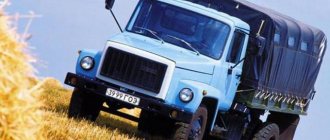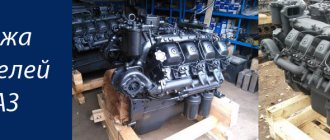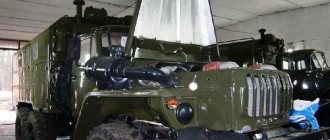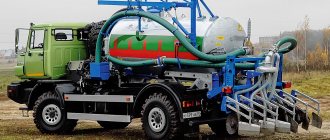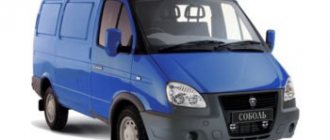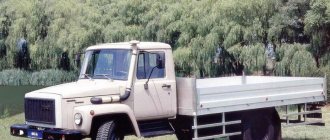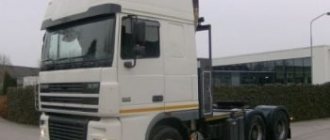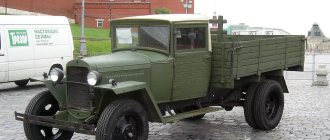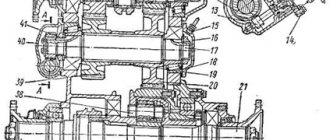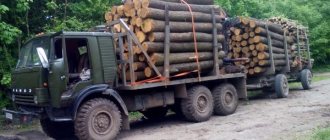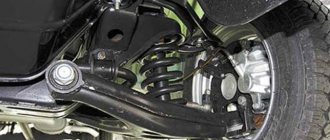About the history of the Ural-375 model
The predecessors of the Ural-375 vehicles in the plant's model range were the UralZIS-355 and UralZIS-355M , produced by the company from the late 40s to 1965. They have proven themselves to be quite reliable, unpretentious and durable cars. Officially considered a 3.5-ton truck, the UralZIS-355 could “take on board” 5-6 tons on a good road and successfully cope with this overload. These hardy trucks brought enormous benefits during the development of the virgin steppes of the Urals, Siberia and Kazakhstan.
And this truck was also at that time the basis of something like the modern KamAZ-Master team: it participated in rallies and auto racing (All-Union motorsport competitions) and took first places in them. In total, over the years of production, about 200,000 UralZIS-355 and UralZIS-355M vehicles were produced.
In the mid-50s, auto designers were given the task: to develop and put into mass production a truck with increased payload and cross-country ability at the level of an all-terrain vehicle. The main consumer of these products was to be the Soviet Army. In 1953, by order of the USSR Ministry of Defense, the Moscow Scientific Research Automotive Institute (NAMI) began developing this project for the UralZIS plant.
The result of this work was the appearance three years later of an experimental 5-ton truck NAMI-020 (6x6) with a 180-horsepower V8 gasoline engine of innovative design, with power steering, all single wheels and a centralized system for regulating tire pressure on the move.
After sea trials, it was recommended for mass production in Miass. The team of the chief designer of the enterprise, S.A., took on the task of finalizing the prototype in accordance with test results and the requirements of military customers. Kurova.
In comparison with the original design of NAMI-020, the gearboxes of all three axles were unified. In this regard, the position of the engine and its systems changed somewhat; changes to the radiator lining, mudguards and wings were required. Unified main gear reducers required the development of a new drive for the steered wheels, and the steering mechanism was redesigned to increase reliability. The redesigned frame and cross members were manufactured at MAZ. Disc wheels were developed, a new winch was developed, the front suspension was changed, etc.
Residents of Miass saw the first two samples of the new, not yet mass-produced, off-road cargo truck, which received the Ural-375 index, at the May Day demonstration in 1958. The first one is with a cab from a new, not yet produced, ZIL-130 truck (but with a different hood); with a windshield reinforced by a central pillar. The second one had an all-metal cabin of its own making.
Factory and then field testing of prototypes of the first series revealed a lot of shortcomings: significant wear and frequent breakdowns of engine parts and its systems, clutch; insufficient rigidity of bridges; self-oscillations of steered wheels; repeated brake failure; unsatisfactory performance of the front suspension on rubber spring supports; spring failures; low tire wear resistance; insufficient reliability of the base and other parts of the cabin and winch. At the same time, the satisfactory operation of the gearbox (this gearbox on YaAZ and MAZ trucks has been tested since the 40s), the transfer case and the tire inflation system, which changes the pressure depending on road conditions from 3.2 to 0.5 kgf/cm², was noted.
After eliminating the identified shortcomings, the Ural-375, already acquiring the familiar features to all of us, was sent to the factory assembly line. It began to be assembled in the plant's workshops in the fall of 1960, and the official launch of the new truck into production took place on January 31, 1961. However, initially the Ural-375 trucks were produced with cabs that had a removable canvas top and a flat windshield that folded down to the level of the hood. And since 1964, the cabin on the Urals became all-metal.
During the years of serial production, work to improve the machine did not stop. Among the important modifications to the car carried out in the first years of production, it should be noted the creation of a bleed line for the engine cooling system, which could operate and circulate water in the event of damage and shutdown of the radiator. Another innovation was a full-flow centrifuge - a centrifugal purifier.
content .. 31 32 37 ..GEARBOX OF CAR URAL-375D
The gearbox (Fig. 40) designed by YaMZ is three-way, has five gears for forward movement and one reverse gear.
The cover of the rear bearing of the intermediate shaft to relieve the clutch housing mounting bolts is used as an additional support for the gearbox. Depending on the distance A between the supporting surfaces of the gearbox cover and the cross member, installation of adjusting shims 1, 2, 3 and 4 (Fig. 41) is provided in the quantity indicated in the table. 6.
Gasket thickness: 1 - 4 mm; 2 - 2 mm; 3 - 1 mm; 4 - 3 mm.
When installing the power unit after dismantling, to ensure correct installation
The number of gaskets and their placement must be maintained.
Primary shaft 1 rotates on two ball bearings (see Fig. 40). One of them is installed in the front wall of the crankcase, and the other is installed in the engine flywheel. The intermediate shaft 39 is also mounted on two bearings. The front end of the secondary shaft 29 rests on a needle bearing placed in a seat
Table 6 de input shaft. The rear end of the output shaft rests on a ball bearing located in the rear wall of the transmission housing.
Ball bearings 2, 25, 38, in addition to radial loads, perceive axial loads and keep the corresponding shafts from longitudinal movements.
The gears of the second, third and fifth gears of the secondary shaft are mounted on needle bearings, and the gears of the first gear and reverse are mounted on the splines of the secondary shaft. All intermediate shaft gears, except gear 40, are keyed. Gear 40, like the input shaft gear, is integral with the shaft. All transmission gears, except first gear, reverse gear and power take-off gear, have helical teeth and are in constant mesh.
For shockless engagement of the second, third, fourth and fifth gears there are two synchronizers 14 and 7 of the inertial type. To ensure that gear shifting is easy and smooth, and the bronze synchronizer rings do not wear out prematurely, it is necessary to adjust the clutch correctly and in a timely manner.
The gear shift mechanism is located in the top cover of the gearbox. It consists of a spring-type fuse 34, which prevents the possibility of accidentally engaging reverse gear when the vehicle is moving forward, and a locking lock, which prevents the possibility of simultaneously engaging two gears.
Lubricate the gearbox in accordance with the lubrication chart. The oil level should match the inspection hole located on the left side of the crankcase. There is a partition inside the crankcase, so it is necessary to drain the oil through the holes of the two drain plugs.
Size A,
mm
| Positions in Fig. 41 and number of gaskets | ||||
| 1 | 2 | 3 | 4 | |
| 35 | 1 | 4 | ||
| 36 | 1 | — | 1 | 4 |
| 37 | 3 | 1 | — | 1 |
| 38 | 2 | 1 | 1 | 2 |
| 39 | 1 | 2 | — | 3 |
| 40 | 3 | 2 | 1 | — |
| 41 | 2 | 3 | — | 1 |
| 42 | 1 | 3 | 1 | 2 |
| 43 | 2 | 4 | — | — |
| 44 | 2 | 4 | 1 | — |
| 45 | 1 | 5 | 1 | |
Needle bearings 9, 13, 16, 20, 50 are forcibly lubricated by an oil pump 48, which is driven by the intermediate shaft. Oil pumped by the pump through a channel made in the front wall of the crankcase enters the channel in the rear bearing cover of the input shaft and then through the input shaft gear bushing into the longitudinal channel of the secondary shaft. From this channel, through radial holes in the secondary shaft, oil flows to the bearings.
When removing and installing the gearbox, it is necessary to suspend it or install supports under it to avoid distortion and breakage of the rivets of the clutch driven disc hub.
Rice. 41. Installation of gearbox support: 1, 2, 3, 4— gaskets
content .. 31 32 37 ..
Ural-375 and its successor - Ural-4320. Other similar cars
In 1977, after the launch of the Kama association for the production of heavy-duty vehicles, Ural trucks began to be equipped not with gasoline, but with diesel engines of the KamAZ-740 series, with a capacity of 210 horsepower, which were much more economical.
The production of a new series of trucks, designated Ural-4320, with diesel engines, was gradually increased, while the production of the gasoline Ural-375, on the contrary, was curtailed.
By 1982, the Soviet Army completely switched from recruiting Urals-375 to Urals-4320, but the Urals-375 continued to serve until decommissioned, according to its service life (12 years). And production of the gasoline version of the SUV truck still continued at UralAZ, in limited quantities, until 1992.
By the way, there is an opinion that the Ural-375 had higher cross-country ability compared to its successor, the Ural-4320.
The ZIL-131 can be called a “classmate” vehicle similar to the Ural-375.
Design features and technical characteristics
This machine was designed primarily for military use. Therefore, the main emphasis was placed on the vehicle’s cross-country ability. It is provided by a 6x6 wheel formula. Two driven rear axles, combined with a forced-shift front axle and a ground clearance of 400 mm, provide the vehicle with the ability to overcome the most difficult terrain obstacles and the most terrifying off-road conditions.
By the way, Ural-375 was exported not only to socialist countries and to states whose elite promised to “follow the path of socialism”, greedily counting on material assistance from the USSR. This truck was very popular in the Middle East (Iran, Iraq, etc.) and North Africa (Egypt).
The Soviet foreign trade association AutoExport Moscow supplied Ural-375, and then Ural-4320, to 20 “far abroad” countries. Even now, sales of Urals to 12 countries continue; the leaders are the Egyptians (94% of all UralAZ exports). Will they be as passionate about the Ural Next car? Time will show.
Dimensions and weight characteristics
- Length: 7,350 m; Width: 2,690 m; Height, without cargo: 2,680 m (in the cabin), 2,980 m (in the awning).
- Wheelbase (distance from the front axle to the middle of the rear bogie base): 4.2 m; rear bogie base: 1,400 m.
- Ground clearance (shortest distance from the road plane to the lowest points of the car) at full load: 400 mm.
- Passage (entry) angles with full load: front (along the buffer) – 44 degrees; rear (according to the towing device) – 40 degrees.
- The front and rear tracks are the same: 2 m.
- Smallest turning radius along the track of the outer front wheel: 10.5 m.
- Loading platform dimensions: 3.9 m x 2.43 m; height of sides (except rear): 872 mm.
- Loading height of cargo platform: 1,420 m.
- Curb vehicle weight: 8 tons.
- Load capacity: 5 tons. Towed trailer weight: up to 10 tons.
- Gross vehicle weight: 13.3 tons.
Volumes of filling tanks Ural-375
- Fuel tanks: main – 300 liters; additional – 60 liters.
- Cooling system: without heater – 27 liters; with heater - 30 liters.
- Engine lubrication system: with oil cooler – 9 liters; without oil cooler - 8.3 liters.
- Engine air filter oil tank: 0.6 l.
- Oil reservoir of the engine crankcase ventilation air filter – 0.07 l.
- Gearbox housing – 4.5 l.
- Transfer case housing - 3.5 liters.
- Gear housings for the front, middle and rear axles (each) – 4 liters.
- Steering gear housing - 1.5 liters.
- Hydraulic steering system with spare wheel lift - 4.5 l.
- Shock absorbers - 1.5 l.
- Hydraulic brake system – 2 l.
Car engine Ural-375
The engine of the 375th "Ural" is an 8-cylinder, V-shaped, four-stroke, carburetor, overhead valve ZIL-375 with a working volume of 7 liters. This engine has a cast iron cylinder block with easily removable plug-in wet liners and rubber rings. Sleeve with acid-resistant insert in the upper part. There are two cylinder heads, aluminum, with insert seats and valve guides.
Aluminum pistons. The piston rings are three compression cast iron (the top two are chrome plated) and one oil scraper steel, composite. Piston pins are steel, floating, hollow.
Connecting rods - steel, I-section, with splash lubrication of the piston pin; the upper head has a bronze bushing Thin-walled connecting rod bearings, interchangeable, steel-aluminum (base - steel 08kp, antifriction alloy - AMO-1-20).
The flywheel is cast iron, with a steel toothed ring. The camshaft is steel, forged, five-bearing. The camshaft drive is a pair of helical gears.
The valves are upper, located in the cylinder heads in a common row obliquely to the cylinder axis; driven by the camshaft using pushers, rods and rocker arms. The exhaust valves are hollow, cooled, with heat-resistant surfacing, and have a ball-type mechanism for forced rotation of the valve during operation.
Engine cooling is liquid, forced with a centrifugal pump with a switchable fan pulley. The cooling system includes a thermostat with solid filler.
The ZIL-375 engine cooling system has a drain line that ensures water circulation in the engine water jacket when the radiator is turned off (bypass).
The main technical parameters of this gasoline engine are as follows:
- Power (maximum, at 3200 rpm): 180 horsepower.
- Maximum torque at 1800-2000 rpm: 47.5 kgf-m.
- Cylinder diameter: 108 mm.
- Piston stroke: 95 mm.
- Compression ratio: 6.
- Firing order: 1 - 5 - 4 - 2 - 6 - 3 - 7 - 8.
A serious drawback of the gasoline engine for the Uralov-375 was its very high fuel consumption, even for Soviet times. According to the manufacturer, it is 48 liters per 100 kilometers.
In reality, and especially when driving a loaded car off-road, consumption reached 70-75 liters of gasoline per “hundred”. For this, the Ural-375, and in fact its engine, was popularly nicknamed “glutton”.
At the same time, it consumed a third more gasoline than the ZIL-131, but it also had a third higher towing capacity and potential productivity (carrying capacity). The Ural-375, with a five-ton load in the back, could also drag a ten-ton trailer along the highway. And ZIL, under the same conditions, has a trailer of only 6.5 tons. On the ground, the Ural carried the same load of 5 tons and a five-ton trailer on its hump. And ZIL - 3.5 tons in the body and four tons on the hook. And the “road” Ural-377, (6x4), still with the same voracious engine, could drag a heavier trailer on the ground than an all-wheel drive three-axle ZIL.
Transmission Ural-375; steering and brake control
The truck is equipped with a YaMZ-204U manual gearbox. It is a three-way transmission, with five forward and one reverse gears, with synchronizers in second, third, fourth and fifth gears. Gear ratios: first gear – 6.17; second gear – 3.40; third gear – 1.79; fourth gear – 1.00; fifth gear – 0.78; reverse - 6.69.
The Ural-375 uses a mechanical, two-stage transfer case (with a “lower”). On cars of early years of production, transfer cases were installed with a cylindrical locking center differential, distributing torque between the front axle and the rear axle bogie in a ratio of 1: 2. That is, with a forced front axle. The transfer case lever had three positions: “front axle off”; “the front axle is on, the center differential is locked”; “the front axle is engaged, the center differential is unlocked.”
Next, a new transfer case of a simplified design was introduced: with a constantly engaged front axle and an asymmetrical locking planetary-type center differential. The clutch on the Ural-375 is dry, double-disc with peripheral springs. The steering mechanism is equipped with a hydraulic booster.
Steering type: two-way worm, gear sector and hydraulic booster. The service brake is a hydraulic drum with a pneumatic booster. Drum brakes, shoe brakes on all wheels; pneumohydraulic drive: for the front and middle axles - joint, for the rear axle - separate
Suspension, chassis, axles Ural-375
The main machine was a stamped riveted frame made of sheet steel. The front suspension consists of two longitudinal semi-elliptical springs.
At the front they are connected to the frame with special fasteners, and at the rear they are sliding. The rear suspension is made of a balancer type and has two semi-elliptic springs, which are attached to sliding supports.
The front axle of the Ural-375 is driven, steered, the axle shafts have disk-type constant-velocity joints. The crankcases of all drive axles are cast steel with pressed semi-axial pipes. The differential is conical, with four satellites. The axle shafts are completely unloaded.
The middle bridge is equipped with limit cables. Reaction rods act as a transmitter of pushing forces. The suspension design includes double-acting telescopic shock absorbers. The wheels are equipped with special OI-25 tires, designated “14.00–20”. The machine is equipped with a system for centrally changing tire pressure (from 0.5 to 3.2 kgf/cm²).
Technical characteristics of "Ural-375D"
Since the Ural-375D was significantly modernized, its technical characteristics also differed from the Ural-375:
- For example, the basic modification of the car already had a metal body, with folding benches for soldiers;
- The sides could be built on using special structures. There was also an awning that was installed to protect passengers or cargo from bad weather conditions;
- The car's cabin was completely metal. The front glass in it no longer lowered onto the hood, but it received a stiffening rib in the middle to strengthen the structure. In the side doors, the windows could be lowered using special rotary handles (the so-called “oars”);
- Thanks to the installation of a new engine, the maximum speed of the Ural-375D increased. Now it reached 75 km/h.
The transmission used was a standard dry double-disc clutch with a simple lever drive and a 5-speed manual gearbox. The car was equipped with a mechanical transfer case with a center differential. An interesting feature of the Ural-375D was the automatic tire inflation system, which even now is very rarely found on modern cars.
Modifications of Ural-375
- Ural-375 - equipped with a cabin with a folding canvas awning. Produced from 1961 to 1964.
- Ural-375D - with an all-metal cabin. Produced since 1964
- Ural-375A – chassis with an extended frame for installing a K-375 van body.
- Ural-375E is a universal chassis for installing various equipment and additional superstructures.
- Ural-375S – truck tractor.
- Ural-375K - specifically for operation in the Far North.
- Ural-375N is a national economic vehicle. External differences from the Ural-375D are the absence of an air intake pipe, a body - a wooden platform with three opening sides, wheels without centralized tire pressure control, tire size - 1100x400-533.
Initially, the Ural-375 model (manufactured in 1961) had a load capacity of 4 tons, by 1964 this figure increased to five tons. The basic modernized model Ural-375D had a carrying capacity of 5 tons on paved roads and 4.5 tons on the ground. The Ural-375A, equipped with an extended base, also acquired the ability to transport even larger cargo, weighing 5.8 tons.
The Ural-375NM vehicles for the national economy can also transport more than five tons. All Urals-375 of these modifications also have the ability to tow trailers with a payload of up to ten tons.
The greatest load can be carried by special tractor-timber trucks Ural-375S, which towed semi-trailers with a 12-ton load, as well as the Ural-375SN and Ural-375SNM that appeared later.
Drivers' reviews of the Ural-375
Most people who had to drive a Ural-375 in their youth (for example, while serving in the army) have only pleasant memories of it, as one of the bright episodes of their youth.
The first thing that everyone who has had driving experience in the Ural-375 mentions is its simply phenomenal all-terrain qualities: “When you turn on the lock and all three axles “row”, this car is very difficult to stop.”
The machine is extremely simple in design, durable and maintainable. Any repair can be done literally in the field. There is, of course, no comfort in the cabin. Despite the fact that it has three seats and is generally quite spacious, you sit in it “like on an ordinary stool.”
In winter, this cabin is warm, but when working in particularly frosty conditions, it is still necessary to insulate it (from the factory, the heat and sound insulation is not at its best). The Ural-375 is very noisy on the highway on its all-terrain tires. But it was not created for the track at all!
Price of the Ural-375 car
You can’t find used Ural-375s: they have already served their purpose. However, in a number of regions there are offers to sell unused Ural-375 vehicles removed from Rosrezerv storage. They ask for them, depending on the type and equipment of the chassis, from 300 to 500 thousand rubles.
In general, the Ural-375 truck was an excellent off-road cargo vehicle of its time. He completed many assigned tasks, delivering military personnel, specialists and required cargo to the most inaccessible and remote areas. This car was able to work in any climatic conditions - severe cold or sweltering heat.
Gearbox in the Urals: device, modifications
As a rule, Ural cars are equipped with a mechanical five-speed, three-shaft, partially synchronized gearbox, which has fixed shaft axes, mixed gearing and a direct drive.
As for the gear ratios, then: first gear, —, 5.96, second, —, 2.90, third, —, 1.52, fourth, —, 1.00, fifth, —, 0.664, reverse gear, —, 5.48. Thanks to the presence of a fifth gear, which has a gear ratio less than one, it is possible to achieve fuel efficiency and also slow down the wear of engine parts. This effect is possible as a result of a decrease in the crankshaft rotation speed at the same vehicle speed.
As a rule, a gearbox for URAL consists of elements such as a crankcase and a top cover, which is equipped with a gear shift mechanism. The crankcase, in turn, houses the primary, secondary and intermediate shafts, bearings, gears and synchronizers.
Most Ural trucks, as already mentioned, are equipped with a five-speed YaMZ-236 gearbox. But some Ural trucks are equipped with a completely different YaMZ-239 gearbox. This box is also mechanical and is distinguished by the presence of a multiplexer. It has nine stages, as well as synchronizers. There is only one reverse gear, without synchronizers.
